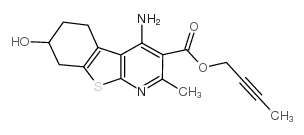SB-205384 is a positive allosteric modulator of recombinant GABAA receptors containing rat α3, α5, or α6 subunit subtypes coexpressed with β3 and γ2 subunits.
Laura S Heidelberg, James W Warren, Janet L Fisher
Index: J. Pharmacol. Exp. Ther. , (2013)
Full Text: HTML
Abstract
Many drugs used to treat anxiety are positive modulators of GABAA receptors, which mediate fast inhibitory neurotransmission. The GABAA receptors can be assembled from a combination of at least 16 different subunits. The receptor's subunit composition determines its pharmacologic and functional properties, and subunit expression varies throughout the brain. A primary goal for new treatments targeting GABAA receptors is the production of subunit-selective modulators acting upon a discrete population of receptors. The anxiolytic 4-amino-7-hydroxy-2-methyl-5,6,7,8,-tetrahydrobenzo[b]thieno[2,3-b]pyridine-3-carboxylic acid, but-2-ynyl ester (SB-205384) is widely considered to be selective for α3-containing GABAA receptors. However, it has been tested only on α1-, α2-, and α3-containing receptors. We examined the activity of SB-205384 at recombinant receptors containing the six different α subunits and found that receptors containing the α3, α5, and α6 subunits were potentiated by SB-205384, with the α6 subunit conferring the greatest responsiveness. Properties associated with chimeric α1/α6 subunits suggested that multiple structural domains influence sensitivity to SB-205384. Point mutations of residues within the extracellular N-terminal domain identified a leucine residue located in loop E of the agonist binding site as an important determinant of high sensitivity to modulation. In the α6 subunit the identity of this residue is species-dependent, with the leucine found in rat subunits but not in human. Our results indicate that SB-205384 is not an α3-selective modulator, and instead acts at several GABAA receptor isoforms. These findings have implications for the side-effect profile of this anxiolytic as well as for its use in neuronal and animal studies as a marker for contribution from α3-containing receptors.
Related Compounds
| Structure | Name/CAS No. | Molecular Formula | Articles |
|---|---|---|---|
 |
SB 205384
CAS:160296-13-9 |
C17H18N2O3S |
|
Quantitative trait locus analysis identifies Gabra3 as a reg...
2010-06-01 [Mamm. Genome 21(5-6) , 247-57, (2010)] |
|
Developmental change in GABAA receptor desensitization kinet...
2000-01-01 [J. Physiol. 522 Pt 1 , 3-17, (2000)] |
|
SB-205384: a GABA(A) receptor modulator with novel mechanism...
1998-03-01 [Br. J. Pharmacol. 123 , 1253-1259, (1998)] |
|
Effect of SB-205384 on the decay of GABA-activated chloride ...
1997-08-01 [Br. J. Pharmacol. 121 , 1334-1338, (1997)] |
|
Loss of leptin receptors on hypothalamic POMC neurons alters...
2010-11-01 [J. Neurophysiol. 104(5) , 2321-8, (2010)] |